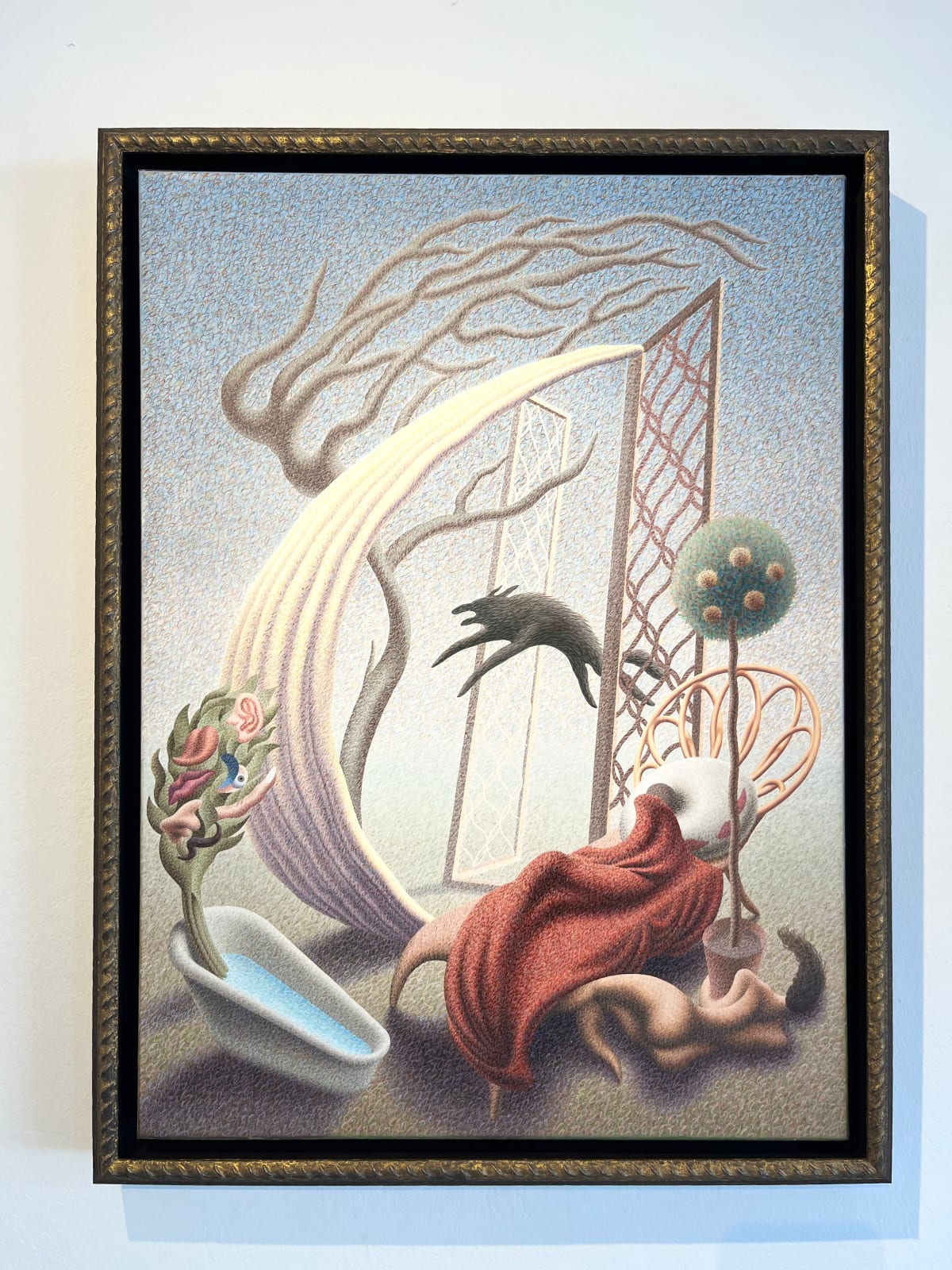-
Artworks
Henry Orlik b. 1947
END OF AN AFFAIRAcrylic on canvasImage H. 66 cm. x W. 48 cm., H. 26 in. x W. 19 in.
Framed H. 71 cm. x W 53.5 cm., H. 28 in. x W. 21 in.With artist's stamp versoWB1523Note: If you are interested in acquiring a work by Henry Orlik, please contact our team to discuss further options.Further images
In a wall-less room, Orlik gives us a windswept landscape dominated by a window blown open by the wind (and if the eye is the window to the soul, then in Orlik’s dream-world surely the window is the eye to the soul). The curtain is blown backward to form a bow-shape, the strange windows or shutters, like stylised trellises, are blown apart and a black cat leaps, or is propelled, through the space; a leaf-less tree with jagged, pointed branches (blowing like dishevelled hair) is contorted by the wind. The foreground is no calmer: a female lies by the side of the bed, her sinuous back and buttocks, and curved legs face us; she clings to a plant-pot that holds a stylised lolly-pop-like tree, of child-like perfection, on which grow five round stylised sweet-like fruits; her hair rises, curved like her body as if it is a bush growing out of the ground. In the left corner of the painting is a stumpy tree, blown by the wind, growing out of a coffin-shaped bath filled with still blue water; on the tree, fruit disembodied features of a head: an ear, lashing tongue, nose, lips, wagging finger, eyeball and socket and moustache: like pieces of a Mr Potato head (sold since 1952). The still points of the painting are the figure tucked up under a brick-red blanket on a bed with delightful, interlaced flower-head wicker headboard, but disturbing claw-like feet; and the upright lolly-pop tree and steady flowerpot. All else is turmoil. One feels the female figure could fit exactly into the curves left on the side of the bed, next to the oblivious sleeping male.
There is so much to contemplate in this painting. Perhaps one thing to consider is the black cat - bad luck if you cross its path and here it is jumping through the window and creating turmoil. Possibly we should think of Orlik’s mother, Lucyna and her family in Belarus, in this context:
In late 1944, as part of the Nazi effort to combat the growing Soviet partisan movement in Belarus during the war, thirty Nazi-supporting and nationalist Belarusians from the espionage and sabotage outfit known as "Čorny Kot" (Black Cat), led by Michal Vituška, were airdropped by the Luftwaffe behind the lines of the Red Army. At that time, the German forces had been expelled from the present-day Belarus during Operation Bagration. The Black Cats experienced some initial successes due to disorganization in the rear of the Red Army. Other German-trained Belarusian nationalist units also slipped through in 1945. Vituška became the leader of a small anti-Soviet movement in Belarus. However, the NKVD (Soviet) secret police informants infiltrated these units and as a result, they were ambushed and killed in short order.
Note: If you are interested in acquiring a work by Henry Orlik, please contact our team to discuss further options.
Join our mailing list
Be the first to hear about our upcoming exhibitions, events and news
* denotes required fields
We will process the personal data you have supplied to communicate with you in accordance with our Privacy Policy. You can unsubscribe or change your preferences at any time by clicking the link in our emails.












